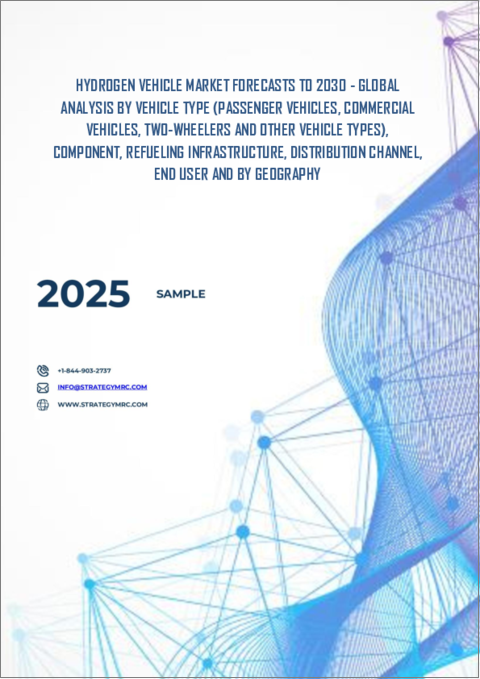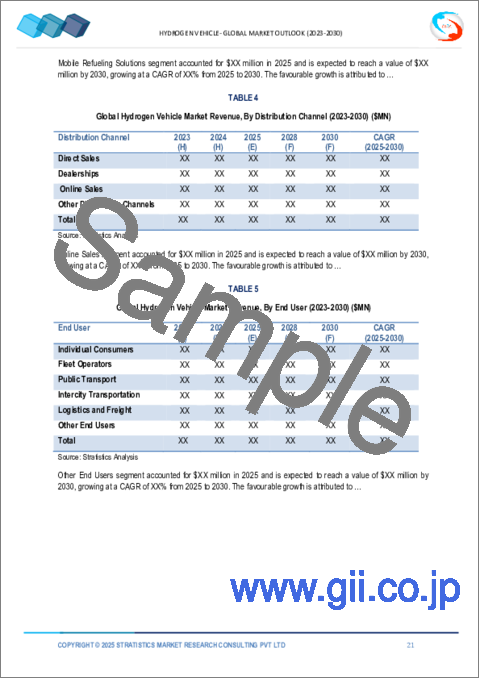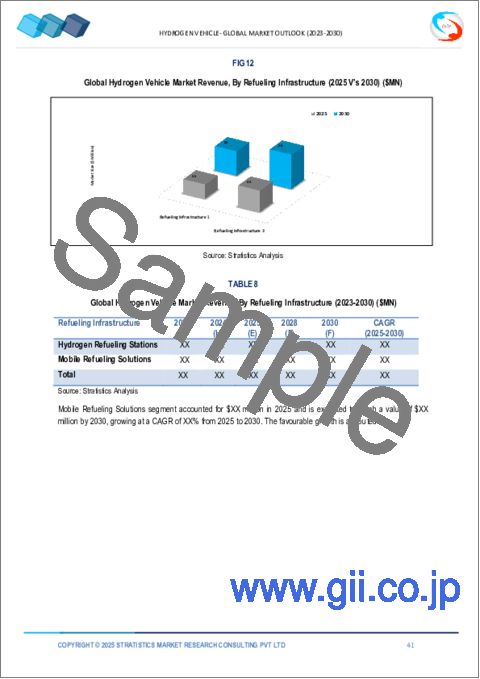|
|
市場調査レポート
商品コード
1617166
水素自動車市場の2030年までの予測: 世界の車両タイプ別、コンポーネント別、燃料補給インフラ別、流通チャネル別、エンドユーザー別、地域別分析Hydrogen Vehicle Market Forecasts to 2030 - Global Analysis By Vehicle Type (Passenger Vehicles, Commercial Vehicles, Two-wheelers and Other Vehicle Types), Component, Refueling Infrastructure, Distribution Channel, End User and By Geography |
||||||
カスタマイズ可能
|
|||||||
| 水素自動車市場の2030年までの予測: 世界の車両タイプ別、コンポーネント別、燃料補給インフラ別、流通チャネル別、エンドユーザー別、地域別分析 |
|
出版日: 2024年12月11日
発行: Stratistics Market Research Consulting
ページ情報: 英文 200+ Pages
納期: 2~3営業日
|
全表示
- 概要
- 図表
- 目次
Stratistics MRCによると、世界の水素自動車市場は2024年に125億7,000万米ドルを占め、予測期間中のCAGRは37.4%で成長し、2030年には845億7,000万米ドルに達すると予測されています。
水素自動車は、水素ガスを燃料とする電気自動車の一種です。水素燃料電池は、水素と酸素を結合させて電気を発生させ、製品別として水蒸気と熱のみを排出します。このため水素自動車は環境にやさしく、従来の内燃機関自動車に代わるクリーンな自動車となります。水素自動車は航続距離が長く、燃料補給に時間がかからないため、持続可能な輸送とグリーン・モビリティへの移行における重要な要素であると考えられています。
水素製造の進歩
風力や太陽光などの再生可能エネルギー源からの水素製造の進歩により、コスト効率と効率が向上しています。こうした技術革新は化石燃料への依存を減らし、水素をよりクリーンな自動車用代替燃料としています。製造技術の向上は水素の総コストを下げ、メーカーと消費者の双方にとってより手頃な価格となります。生産能力の向上により、燃料補給ステーションへの水素の安定供給が確保されます。製造コストが下がるにつれて、水素自動車は電気自動車との競合が激しくなります。このような進歩は、水素が実行可能で持続可能な輸送用燃料として確立され、市場の普及を加速するのに役立ちます。
高い製造コスト
水素燃料電池、貯蔵タンク、関連部品などの材料は、プラチナのような希少材料を使用するため製造コストが高いです。このため、水素自動車の全体的なコストが高くなり、従来の自動車やバッテリー式電気自動車と比べて消費者の手が届きにくくなります。さらに、生産規模が限定的でサプライ・チェーンが非効率であることも、コスト上昇の一因となっています。大衆市場への導入が進んでいないため、規模の経済がさらに制限され、価格が高止まりしています。生産コストが低下するまでは、水素自動車の普及は課題として残ると思われます。
燃料補給インフラの拡大
水素充填インフラの拡大により、より多くの充填ステーションが必要となり、水素自動車の利便性とアクセシビリティが向上し、航続距離に対する不安に対する消費者の懸念に対応できるようになります。インフラが拡大することで、水素自動車を使用する企業やフリートオペレーターの業務上の障壁が軽減されます。燃料補給ネットワークが拡大するにつれて、メーカーは水素自動車を生産する傾向が強まり、市場供給が促進されます。さらに、政府による燃料補給インフラへの投資は、水素自動車の採用をさらに促進します。最終的には、インフラの拡大が水素を燃料とする輸送手段への移行を加速させる。
サプライチェーンの脆弱性
燃料電池に使用されるプラチナのような原材料の供給が途絶えると、コストが上昇し、製造が遅れる可能性があります。水素ステーションが限られているため、水素自動車の普及がさらに制限されます。世界貿易の不確実性や地政学的緊張は、重要部品のタイムリーな供給を妨げる可能性があります。こうしたサプライチェーンの問題は、水素自動車をより高価で身近なものにします。さらに、生産のボトルネックにより、市場における車両の供給力が低下する可能性もあります。
COVID-19の影響
COVID-19の大流行は、生産、サプライチェーン、消費者の需要を混乱させることにより、水素自動車市場に大きな影響を与えました。工場の閉鎖や操業停止は、自動車の製造やインフラ開発を遅らせ、経済の不確実性はグリーン技術への投資の減少につながった。しかし、パンデミックによって環境問題への意識も高まり、各国政府は復興計画において持続可能な解決策を優先するようになった。このクリーンエネルギーとグリーンモビリティへのシフトは、パンデミック後の経済再建努力の一環として、水素自動車への新たな関心を呼び起こしました。
予測期間中、燃料電池分野が最大となる見込み
燃料電池分野は、クリーンエネルギー変換の中核技術であるため、予測期間を通じて最大の市場シェアを確保すると予測されます。燃料電池は、水素と酸素を結合させて発電し、製品別として水蒸気のみを発生させるため、水素自動車は環境に優しいです。燃料電池技術の進歩により効率が改善され、コストが下がり、車の性能が向上しています。燃料電池システムの価格と信頼性が高まるにつれ、自動車メーカーは水素自動車への投資に積極的になっています。このため、特に商用車や大型車向けの水素自動車の採用が進んでいます。
予測期間中、CAGRが最も高くなると予想されるのは公共輸送分野です。
公共輸送分野は、持続可能な輸送ソリューションにより、予測期間中に大幅な成長が見込まれます。水素バス、電車、その他の公共交通機関は、ゼロ・エミッションの代替手段を提供し、都市の大気汚染と気候目標に対処します。公共交通機関に水素自動車を採用することで、化石燃料への依存を減らし、長期的な運営コストを削減することができます。燃料補給ステーションのような水素インフラへの投資は、公共部門のイニシアチブによって加速されます。このような広範な展開は、消費者の信頼を高め、より広範な市場導入を促します。
最大のシェアを占める地域:
予測期間中、政府の強力な支援、技術の進歩、環境意識の高まりにより、アジア太平洋地域が最大の市場シェアを占めると予想されます。日本、韓国、中国のような国々が水素自動車の開発でリードしており、トヨタ、現代自動車、ホンダなどの大手メーカーが燃料電池技術に多額の投資を行っています。この地域は水素燃料補給インフラを急速に拡大しており、より幅広い普及を促しています。さらに、各国政府はクリーンなエネルギー源として水素を促進する政策やインセンティブを実施しており、アジア太平洋地域における水素自動車の成長に有利な環境を作り出しています。
CAGRが最も高い地域:
予測期間中、政府の強力な支援と環境意識の高まりにより、北米地域が最も高いCAGRを示すと予想されます。米国とカナダは、様々な自動車メーカーが水素自動車を発売し、燃料補給インフラを拡充していることから、水素燃料電池技術の採用で先行しています。トヨタ、現代自動車、ホンダなどの主な企業は、水素自動車の開発に積極的に投資しています。さらに、温室効果ガスの排出削減とクリーンエネルギーの推進に向けた取り組みが、市場の成長を加速させています。再生可能エネルギーの統合と持続可能な輸送ソリューションに注力する北米は、水素自動車を将来のモビリティの重要な構成要素として位置づけています。
無料のカスタマイズサービス
本レポートをご購読のお客様には、以下の無料カスタマイズオプションのいずれかをご利用いただけます:
- 企業プロファイル
- 追加市場プレーヤーの包括的プロファイリング(3社まで)
- 主要企業のSWOT分析(3社まで)
- 地域セグメンテーション
- 顧客の関心に応じた主要国の市場推計・予測・CAGR(注:フィージビリティチェックによる)
- 競合ベンチマーキング
- 製品ポートフォリオ、地理的プレゼンス、戦略的提携に基づく主要企業のベンチマーキング
目次
第1章 エグゼクティブサマリー
第2章 序文
- 概要
- ステークホルダー
- 調査範囲
- 調査手法
- データマイニング
- データ分析
- データ検証
- 調査アプローチ
- 調査情報源
- 1次調査情報源
- 2次調査情報源
- 前提条件
第3章 市場動向分析
- ドライバー
- 抑制要因
- 機会
- 脅威
- エンドユーザー分析
- 新興市場
- COVID-19の影響
第4章 ポーターのファイブフォース分析
- 供給企業の交渉力
- 買い手の交渉力
- 代替品の脅威
- 新規参入業者の脅威
- 競争企業間の敵対関係
第5章 世界の水素自動車市場:車両タイプ別
- 乗用車
- 商用車
- 二輪車
- 大型車両
- その他の車両タイプ
第6章 世界の水素自動車市場:コンポーネント別
- 燃料電池
- 水素貯蔵システム
- 電気モーター
- バッテリー
- インフラの燃料供給
- その他のコンポーネント
第7章 世界の水素自動車市場:燃料補給インフラ別
- 水素燃料補給ステーション
- モバイル給油ソリューション
第8章 世界の水素自動車市場:流通チャネル別
- 直接販売
- ディーラー
- オンライン販売
- その他の流通チャネル
第9章 世界の水素自動車市場:エンドユーザー別
- 個人消費者
- フリートオペレーター
- 公共交通機関
- 都市間交通
- 物流と貨物輸送
- その他のエンドユーザー
第10章 世界の水素自動車市場:地域別
- 北米
- 米国
- カナダ
- メキシコ
- 欧州
- ドイツ
- 英国
- イタリア
- フランス
- スペイン
- その他欧州
- アジア太平洋
- 日本
- 中国
- インド
- オーストラリア
- ニュージーランド
- 韓国
- その他アジア太平洋
- 南米
- アルゼンチン
- ブラジル
- チリ
- その他南米
- 中東・アフリカ
- サウジアラビア
- アラブ首長国連邦
- カタール
- 南アフリカ
- その他中東とアフリカ
第11章 主な発展
- 契約、パートナーシップ、コラボレーション、合弁事業
- 買収と合併
- 新製品発売
- 事業拡大
- その他の主要戦略
第12章 企業プロファイリング
- Toyota Motor Corporation
- Honda Motor Co., Ltd.
- Hyundai Motor Company
- BMW Group
- Mercedes-Benz(Daimler AG)
- Ford Motor Company
- General Motors(GM)
- Nissan Motor Co., Ltd.
- Volkswagen Group
- Audi AG
- Ballard Power Systems
- Plug Power Inc.
- Nikola Corporation
- Cummins Inc.
- Hydrogenics Corporation(Cummins Inc.)
List of Tables
- Table 1 Global Hydrogen Vehicle Market Outlook, By Region (2022-2030) ($MN)
- Table 2 Global Hydrogen Vehicle Market Outlook, By Vehicle Type (2022-2030) ($MN)
- Table 3 Global Hydrogen Vehicle Market Outlook, By Passenger Vehicles (2022-2030) ($MN)
- Table 4 Global Hydrogen Vehicle Market Outlook, By Commercial Vehicles (2022-2030) ($MN)
- Table 5 Global Hydrogen Vehicle Market Outlook, By Two-wheelers (2022-2030) ($MN)
- Table 6 Global Hydrogen Vehicle Market Outlook, By Heavy Duty Vehicles (2022-2030) ($MN)
- Table 7 Global Hydrogen Vehicle Market Outlook, By Other Vehicle Types (2022-2030) ($MN)
- Table 8 Global Hydrogen Vehicle Market Outlook, By Component (2022-2030) ($MN)
- Table 9 Global Hydrogen Vehicle Market Outlook, By Fuel Cells (2022-2030) ($MN)
- Table 10 Global Hydrogen Vehicle Market Outlook, By Hydrogen Storage Systems (2022-2030) ($MN)
- Table 11 Global Hydrogen Vehicle Market Outlook, By Electric Motors (2022-2030) ($MN)
- Table 12 Global Hydrogen Vehicle Market Outlook, By Batteries (2022-2030) ($MN)
- Table 13 Global Hydrogen Vehicle Market Outlook, By Fuelling Infrastructure (2022-2030) ($MN)
- Table 14 Global Hydrogen Vehicle Market Outlook, By Other Components (2022-2030) ($MN)
- Table 15 Global Hydrogen Vehicle Market Outlook, By Refueling Infrastructure (2022-2030) ($MN)
- Table 16 Global Hydrogen Vehicle Market Outlook, By Hydrogen Refueling Stations (2022-2030) ($MN)
- Table 17 Global Hydrogen Vehicle Market Outlook, By Mobile Refueling Solutions (2022-2030) ($MN)
- Table 18 Global Hydrogen Vehicle Market Outlook, By Distribution Channel (2022-2030) ($MN)
- Table 19 Global Hydrogen Vehicle Market Outlook, By Direct Sales (2022-2030) ($MN)
- Table 20 Global Hydrogen Vehicle Market Outlook, By Dealerships (2022-2030) ($MN)
- Table 21 Global Hydrogen Vehicle Market Outlook, By Online Sales (2022-2030) ($MN)
- Table 22 Global Hydrogen Vehicle Market Outlook, By Other Distribution Channels (2022-2030) ($MN)
- Table 23 Global Hydrogen Vehicle Market Outlook, By End User (2022-2030) ($MN)
- Table 24 Global Hydrogen Vehicle Market Outlook, By Individual Consumers (2022-2030) ($MN)
- Table 25 Global Hydrogen Vehicle Market Outlook, By Fleet Operators (2022-2030) ($MN)
- Table 26 Global Hydrogen Vehicle Market Outlook, By Public Transport (2022-2030) ($MN)
- Table 27 Global Hydrogen Vehicle Market Outlook, By Intercity Transportation (2022-2030) ($MN)
- Table 28 Global Hydrogen Vehicle Market Outlook, By Logistics and Freight (2022-2030) ($MN)
- Table 29 Global Hydrogen Vehicle Market Outlook, By Other End Users (2022-2030) ($MN)
Note: Tables for North America, Europe, APAC, South America, and Middle East & Africa Regions are also represented in the same manner as above.
According to Stratistics MRC, the Global Hydrogen Vehicle Market is accounted for $12.57 billion in 2024 and is expected to reach $84.57 billion by 2030 growing at a CAGR of 37.4% during the forecast period. A hydrogen vehicle is a type of electric vehicle that uses hydrogen gas as its fuel source. The vehicle is powered by a hydrogen fuel cell, which combines hydrogen with oxygen to produce electricity, emitting only water vapour and heat as by products. This makes hydrogen vehicles environmentally friendly and a cleaner alternative to conventional internal combustion engine vehicles. They offer long driving ranges; quick refueling times, and is considered a key component in sustainable transportation and the transition to green mobility.
Market Dynamics:
Driver:
Advancements in hydrogen production
Advancements in hydrogen production from renewable energy sources like wind and solar, is becoming more cost-effective and efficient. These innovations reduce the reliance on fossil fuels, making hydrogen a cleaner alternative for vehicles. Improved production techniques lower the overall cost of hydrogen, making it more affordable for both manufacturers and consumers. Increased production capacity ensures a steady supply of hydrogen for refueling stations. As production costs decrease, hydrogen vehicles become more competitive with electric vehicles. These advancements help establish hydrogen as a viable, sustainable fuel for transportation, accelerating market adoption.
Restraint:
High cost of production
The high cost of production for materials such as hydrogen fuel cells, storage tanks, and related components are expensive to manufacture due to the use of rare materials like platinum. This increases the overall cost of hydrogen vehicles, making them less affordable for consumers compared to traditional vehicles or battery electric vehicles. Additionally, the limited scale of production and supply chain inefficiencies contribute to higher costs. The lack of mass-market adoption further restricts economies of scale, keeping prices high. Until production costs decrease, widespread adoption of hydrogen vehicles will remain challenging.
Opportunity:
Expansion of refueling infrastructure
The expansion of hydrogen refueling infrastructure, needs more refueling stations, the convenience and accessibility of hydrogen vehicles improve, addressing consumer concerns about range anxiety. This increased infrastructure reduces operational barriers for businesses and fleet operators using hydrogen-powered vehicles. As refueling networks grow, manufacturers are more inclined to produce hydrogen vehicles, boosting market supply. Additionally, government investments in refueling infrastructure further promote the adoption of hydrogen vehicles. Ultimately, the expanded infrastructure accelerates the transition to hydrogen-powered transportation.
Threat:
Supply chain vulnerabilities
Disruptions in the supply of raw materials like platinum, used in fuel cells, can increase costs and slow down manufacturing. Limited availability of hydrogen refueling stations further restricts vehicle adoption. Global trade uncertainties and geopolitical tensions can interrupt the timely delivery of essential parts. These supply chain issues make hydrogen vehicles more expensive and less accessible. Additionally, production bottlenecks can lead to lower vehicle availability in the market.
Covid-19 Impact
The COVID-19 pandemic significantly impacted the hydrogen vehicle market by disrupting production, supply chains, and consumer demand. Lockdowns and factory closures delayed vehicle manufacturing and infrastructure development, while economic uncertainty led to reduced investments in green technologies. However, the pandemic also heightened awareness of environmental issues, driving governments to prioritize sustainable solutions in their recovery plans. This shift towards clean energy and green mobility has sparked renewed interest in hydrogen vehicles as part of post-pandemic economic rebuilding efforts.
The fuel cells segment is expected to be the largest during the forecast period
The fuel cells segment is predicted to secure the largest market share throughout the forecast period, due to the core technology for clean energy conversion. Fuel cells generate electricity by combining hydrogen with oxygen, producing only water vapour as a by-product, making hydrogen vehicles environmentally friendly. The advancement of fuel cell technology has led to improved efficiency, driving down costs and increasing vehicle performance. As fuel cell systems become more affordable and reliable, automakers are more inclined to invest in hydrogen-powered vehicles. This enhances the adoption of hydrogen vehicles, especially for commercial and heavy-duty applications.
The public transport segment is expected to have the highest CAGR during the forecast period
The public transport segment is projected to witness substantial growth during the estimation period, due to sustainable transport solutions. Hydrogen buses, trains, and other forms of public transit offer zero-emission alternatives, addressing urban air pollution and climate goals. The adoption of hydrogen vehicles in public transport helps reduce fossil fuel dependence and lowers operating costs over time. Investments in hydrogen infrastructure, like refueling stations, are accelerated by public sector initiatives. This widespread deployment boosts consumer confidence and encourages broader market adoption.
Region with largest share:
During the projected timeframe, the Asia Pacific region is expected to hold the largest market share due to strong government support, technological advancements, and increasing environmental awareness. Countries like Japan, South Korea, and China are leading in hydrogen vehicle development, with major manufacturers such as Toyota, Hyundai, and Honda investing heavily in fuel cell technologies. The region is rapidly expanding its hydrogen refueling infrastructure, encouraging broader adoption. Moreover, governments are implementing policies and incentives to promote hydrogen as a clean energy source, creating a favourable environment for the growth of hydrogen-powered vehicles in the Asia Pacific.
Region with highest CAGR:
Over the forecasted timeframe, the North America region is anticipated to exhibit the highest CAGR, by strong government support and increasing environmental awareness. The U.S. and Canada are leading the way in adopting hydrogen fuel cell technology, with various automakers launching hydrogen-powered vehicles and expanding refueling infrastructure. Key players like Toyota, Hyundai, and Honda are actively investing in hydrogen vehicle development. Additionally, initiatives to reduce greenhouse gas emissions and promote clean energy are accelerating market growth. North America's focus on renewable energy integration and sustainable transportation solutions is positioning hydrogen vehicles as a key component of future mobility.
Key players in the market
Some of the key players profiled in the Hydrogen Vehicle Market include Toyota Motor Corporation, Honda Motor Co., Ltd., Hyundai Motor Company, BMW Group, Mercedes-Benz (Daimler AG), Ford Motor Company, General Motors (GM), Nissan Motor Co., Ltd., Volkswagen Group, Audi AG, Ballard Power Systems, Plug Power Inc., Nikola Corporation, Cummins Inc. and Hydrogenics Corporation (Cummins Inc.)
Key Developments:
In November 2024, Toyota Motor Europe entered into a groundbreaking cooperation with Karsan to equip Karsan's hydrogen buses with Toyota's fuel cell modules. This partnership aims to enhance public transport sustainability through advanced hydrogen technology.
In September 2024, Toyota and BMW Group announced an extension of their collaboration in the hydrogen sector. The partnership aims to create a broader range of fuel cell electric vehicles (FCEVs) and enhance infrastructure development for hydrogen supply.
In May 2023, Honda and Isuzu Motors Limited entered into a partnership where Honda will develop and supply the fuel cell (FC) system for Isuzu's upcoming fuel cell-powered heavy-duty truck. This collaboration aims to leverage hydrogen technology to achieve carbon neutrality in heavy-duty vehicles.
Vehicle Types Covered:
- Passenger Vehicles
- Commercial Vehicles
- Two-wheelers
- Heavy Duty Vehicles
- Other Vehicle Types
Components Covered:
- Fuel Cells
- Hydrogen Storage Systems
- Electric Motors
- Batteries
- Fuelling Infrastructure
- Other Components
Refueling Infrastructures Covered:
- Hydrogen Refueling Stations
- Mobile Refueling Solutions
Distribution Channels Covered:
- Direct Sales
- Dealerships
- Online Sales
- Other Distribution Channels
End Users Covered:
- Individual Consumers
- Fleet Operators
- Public Transport
- Intercity Transportation
- Logistics and Freight
- Other End Users
Regions Covered:
- North America
- US
- Canada
- Mexico
- Europe
- Germany
- UK
- Italy
- France
- Spain
- Rest of Europe
- Asia Pacific
- Japan
- China
- India
- Australia
- New Zealand
- South Korea
- Rest of Asia Pacific
- South America
- Argentina
- Brazil
- Chile
- Rest of South America
- Middle East & Africa
- Saudi Arabia
- UAE
- Qatar
- South Africa
- Rest of Middle East & Africa
What our report offers:
- Market share assessments for the regional and country-level segments
- Strategic recommendations for the new entrants
- Covers Market data for the years 2022, 2023, 2024, 2026, and 2030
- Market Trends (Drivers, Constraints, Opportunities, Threats, Challenges, Investment Opportunities, and recommendations)
- Strategic recommendations in key business segments based on the market estimations
- Competitive landscaping mapping the key common trends
- Company profiling with detailed strategies, financials, and recent developments
- Supply chain trends mapping the latest technological advancements
Free Customization Offerings:
All the customers of this report will be entitled to receive one of the following free customization options:
- Company Profiling
- Comprehensive profiling of additional market players (up to 3)
- SWOT Analysis of key players (up to 3)
- Regional Segmentation
- Market estimations, Forecasts and CAGR of any prominent country as per the client's interest (Note: Depends on feasibility check)
- Competitive Benchmarking
- Benchmarking of key players based on product portfolio, geographical presence, and strategic alliances
Table of Contents
1 Executive Summary
2 Preface
- 2.1 Abstract
- 2.2 Stake Holders
- 2.3 Research Scope
- 2.4 Research Methodology
- 2.4.1 Data Mining
- 2.4.2 Data Analysis
- 2.4.3 Data Validation
- 2.4.4 Research Approach
- 2.5 Research Sources
- 2.5.1 Primary Research Sources
- 2.5.2 Secondary Research Sources
- 2.5.3 Assumptions
3 Market Trend Analysis
- 3.1 Introduction
- 3.2 Drivers
- 3.3 Restraints
- 3.4 Opportunities
- 3.5 Threats
- 3.6 End User Analysis
- 3.7 Emerging Markets
- 3.8 Impact of Covid-19
4 Porters Five Force Analysis
- 4.1 Bargaining power of suppliers
- 4.2 Bargaining power of buyers
- 4.3 Threat of substitutes
- 4.4 Threat of new entrants
- 4.5 Competitive rivalry
5 Global Hydrogen Vehicle Market, By Vehicle Type
- 5.1 Introduction
- 5.2 Passenger Vehicles
- 5.3 Commercial Vehicles
- 5.4 Two-wheelers
- 5.5 Heavy Duty Vehicles
- 5.6 Other Vehicle Types
6 Global Hydrogen Vehicle Market, By Component
- 6.1 Introduction
- 6.2 Fuel Cells
- 6.3 Hydrogen Storage Systems
- 6.4 Electric Motors
- 6.5 Batteries
- 6.6 Fueling Infrastructure
- 6.7 Other Components
7 Global Hydrogen Vehicle Market, By Refueling Infrastructure
- 7.1 Introduction
- 7.2 Hydrogen Refueling Stations
- 7.3 Mobile Refueling Solutions
8 Global Hydrogen Vehicle Market, By Distribution Channel
- 8.1 Introduction
- 8.2 Direct Sales
- 8.3 Dealerships
- 8.4 Online Sales
- 8.5 Other Distribution Channels
9 Global Hydrogen Vehicle Market, By End User
- 9.1 Introduction
- 9.2 Individual Consumers
- 9.3 Fleet Operators
- 9.4 Public Transport
- 9.5 Intercity Transportation
- 9.6 Logistics and Freight
- 9.7 Other End Users
10 Global Hydrogen Vehicle Market, By Geography
- 10.1 Introduction
- 10.2 North America
- 10.2.1 US
- 10.2.2 Canada
- 10.2.3 Mexico
- 10.3 Europe
- 10.3.1 Germany
- 10.3.2 UK
- 10.3.3 Italy
- 10.3.4 France
- 10.3.5 Spain
- 10.3.6 Rest of Europe
- 10.4 Asia Pacific
- 10.4.1 Japan
- 10.4.2 China
- 10.4.3 India
- 10.4.4 Australia
- 10.4.5 New Zealand
- 10.4.6 South Korea
- 10.4.7 Rest of Asia Pacific
- 10.5 South America
- 10.5.1 Argentina
- 10.5.2 Brazil
- 10.5.3 Chile
- 10.5.4 Rest of South America
- 10.6 Middle East & Africa
- 10.6.1 Saudi Arabia
- 10.6.2 UAE
- 10.6.3 Qatar
- 10.6.4 South Africa
- 10.6.5 Rest of Middle East & Africa
11 Key Developments
- 11.1 Agreements, Partnerships, Collaborations and Joint Ventures
- 11.2 Acquisitions & Mergers
- 11.3 New Product Launch
- 11.4 Expansions
- 11.5 Other Key Strategies
12 Company Profiling
- 12.1 Toyota Motor Corporation
- 12.2 Honda Motor Co., Ltd.
- 12.3 Hyundai Motor Company
- 12.4 BMW Group
- 12.5 Mercedes-Benz (Daimler AG)
- 12.6 Ford Motor Company
- 12.7 General Motors (GM)
- 12.8 Nissan Motor Co., Ltd.
- 12.9 Volkswagen Group
- 12.10 Audi AG
- 12.11 Ballard Power Systems
- 12.12 Plug Power Inc.
- 12.13 Nikola Corporation
- 12.14 Cummins Inc.
- 12.15 Hydrogenics Corporation (Cummins Inc.)





